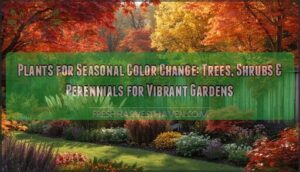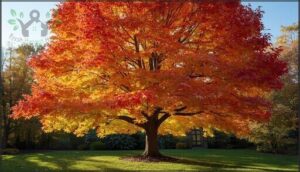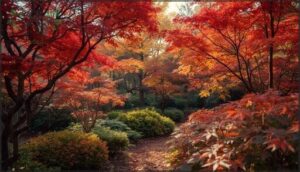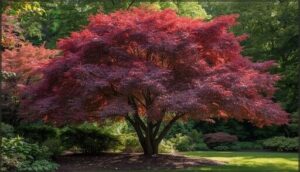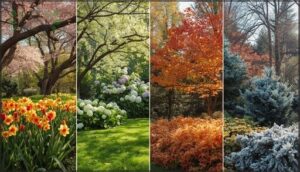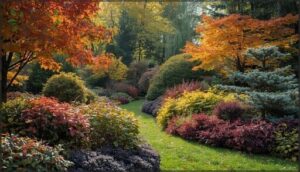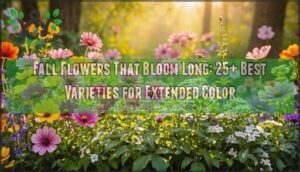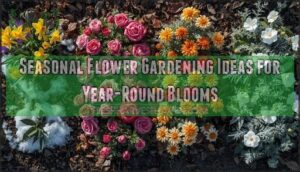This site is supported by our readers. We may earn a commission, at no cost to you, if you purchase through links.
When autumn arrives and the air sharpens, certain plants don’t settle for dull—they throw a festival in your backyard. It’s not just maples that set leaves ablaze; watch closely and you’ll spot shrubs that burn scarlet, vines that sprawl in rivers of fire, and perennials lighting up beds with surprise bursts of color.
Selecting the right plants for seasonal color change lets you choreograph this spectacle year after year, turning ordinary garden beds into living tapestries that shift with every breeze. Let’s dig into the choices that let your landscape own every season.
Table Of Contents
Key Takeaways
- Choosing plants like maples, ginkgo, and burning bush creates a garden that shifts with vibrant color through every season.
- Blending trees, shrubs, vines, and perennials allows you to choreograph continuous color and texture, turning your yard into a living tapestry.
- Picking plants suited to your climate and caring for them well ensures strong color displays and healthy, low-maintenance landscapes.
- Color-changing plants support wildlife, help clean the air, and add year-round visual interest, but it’s important to know which ones might be toxic to pets.
Top Trees for Dramatic Seasonal Color
When it comes to unforgettable color in your garden, the right trees can steal the show. Some varieties offer a stunning display you’ll look forward to year after year.
Here are standout choices known for their dramatic seasonal change.
Sugar Maple ‘Fall Fiesta’
Among the top trees for fall color, Sugar Maple ‘Fall Fiesta’ bursts onto the autumn scene with long-lasting leaves that shift from deep green to vibrant orange, red, and yellow. Its sturdy, pest-resistant foliage stands up to wind and drought, thriving in hardiness zones 3–8.
With moderate growth and low maintenance, this maple anchors any landscape with reliable fall color change and shade. For best growth, expert care is essential.
Ginkgo Biloba ‘Goldspire’
If you’re craving a tree that stops people in their tracks, Ginkgo Biloba ‘Goldspire’ stands tall—literally. This Columnar Ginkgo, a golden foliage champion, delivers vivid golden yellow fall foliage with minimal fuss. With its rigidly columnar form, the Goldspire Ginkgo makes a striking statement.
Urban Tolerance and Low Maintenance combine in this male cultivar, making ‘Goldspire’ a top pick for:
- Small city gardens
- Bold vertical accents
- Clean sidewalks
- Dazzling autumn shows
Japanese Maple Varieties
Japanese Maple trees stand out for their exceptional cultivar diversity and kaleidoscopic fall color change. Their leaf dynamics—think deep crimson, fiery orange, or golden hues—enhance any garden, while compact growth habits make them ideal for small spaces.
From affordable to high market value collector’s pieces, you’ll find this ornamental tree species surprisingly easy to manage, especially regarding pest management.
Sweetgum and Serviceberry
If you’re searching for big autumn drama, Sweetgum trees put on a show with leaves that swirl from yellow to burgundy and purple—often all at once.
Serviceberry, meanwhile, charms in every season: delicate spring blossoms, summer berries relished by birds, and fiery fall foliage.
Both offer strong environmental tolerance and four-season appeal, making them standouts in landscape applications.
Purple Copper Beech
The Purple Copper Beech is a showstopper among colorchanging plants, flaunting deep purple spring leaves that mellow to copper-red in fall foliage.
You’ll appreciate its Foliage Coloration and Beech Hardiness, thriving in cool climates with moist, well-drained soil preferences. Disease Resistance is strong, and regular pruning needs are minimal—ideal for gardeners craving bold trees or striking shrubs with reliable beauty.
Shrubs That Transform Through The Seasons
Shrubs are the unsung heroes of the seasonal garden, transforming your landscape with simple charm. As the months pass, these plants reveal fresh colors and textures that keep things lively.
Let’s explore some favorite shrubs that stand out for their shifting beauty.
Burning Bush (Euonymus Alatus)
Regarding shrubs with unforgettable fall color change, burning bush stands out—its foliage shifts from deep green to blazing scarlet, lighting up any border.
Yet, its invasive potential can’t be ignored; dense thickets shade out natives, with real ecological impacts.
If you love dramatic fall coloration, pair horticultural usage with smart control measures to keep balance in your landscape.
Viburnum ‘Autumn Jazz’
Within your lineup of shrubs transforming all season, Viburnum ‘Autumn Jazz’ deserves a spot. Imagine this: 1. Fall color dancing from yellow to burgundy, 2. Upright, dense growth habits needing little fuss, 3. Clusters of creamy flowers, then blue-black fruit, 4. Adaptability to sun, shade, and varied soils, 5. Excellent disease resistance—this viburnum delivers non-stop garden interest and color variations.
Virginia Sweetspire ‘Henry’s Garnet’
Ever wonder which shrub keeps your garden colorful right through winter’s first frost? Virginia Sweetspire ‘Henry’s Garnet’ is your secret weapon. Its fall color duration is unparalleled—vivid burgundy holding long into December. With forgiving habitat tolerance, arching growth habits, strong wildlife attraction, and fuss-free landscape uses, this shrub’s a staple for anyone craving show-stopping, reliable fall color change.
| Feature | Benefit | Best Use |
|---|---|---|
| Fall Color Duration | Vivid burgundy into winter | Multi-season borders |
| Habitat Tolerance | Sun, shade, wet/dry soils | Rain gardens/slopes |
| Growth Habits | Mounded, arching branches | Groundcover/masses |
| Wildlife Attraction | Pollinator and bird-friendly | Ecological gardens |
| Landscape Uses | Hedge, erosion control, accent | Low-maintenance design |
Witch Hazel ‘Golden Eclipse’
Looking for a shrub that grabs attention with golden foliage and fragrant blooms? Witch Hazel ‘Golden Eclipse’ stands tall, offering a vase-shaped growth habit, vibrant fall color change, and surprising adaptability to tricky soils and climates.
This reliable ornamental shrub brightens late fall but also delivers structure and seasonal color changes, turning every garden moment into a small celebration.
Spirea and Hydrangea Shrubs
Curious how your yard can dazzle from spring through fall? Spirea and hydrangea shrubs are true shapeshifters, flaunting flower color shifts and dramatic foliage changes. You’ll love how:
- Spirea bloom periods span spring to fall
- Hydrangea soil pH transforms flower color
- Reliable cultivars promise repeat displays
- Fall color change never disappoints
- Landscape usage trends favor these resilient flowering shrubs
Vines and Perennials for Color Shifts
There’s something magical about watching vines and perennials shift through the seasons, their colors marking the slow march of time. If you want long-lasting interest, these plants never disappoint—offering surprises well after summer fades.
Let’s take a look at some of the best choices for vibrant, eye-catching displays.
Virginia Creeper
Among fall color stars, Virginia Creeper deserves your attention for its dramatic color transitions and sprawling growth habits. With a habitat range stretching from woodlands to urban fences, it cloaks spaces in vibrant hues from bronze to crimson-red.
Its autumn foliage delivers bold visual impact, while berries lure wildlife, turning your seasonal garden into a lively hub for birds each year.
Clematis and Honeysuckle
If you’re after a garden feature that keeps you guessing, Clematis and Honeysuckle pull it off with style. Their bloom color shift and foliage longevity let you enjoy color transitions through most of the year.
Clever pruning influences reblooming, and weaving these climbing vines together creates vine combinations that bring unexpected richness and texture to your garden design.
Seasonal Bulb Gardens
If you love a surprise, a seasonal Bulb Garden is your playground. From early-blooming crocus to classic tulips and daffodils, these seasonal plants roll out color in waves every Spring.
Bulb blooming patterns and bulb longevity mean your display lasts and grows.
Thanks to steady bulb market trends and affordable bulb cost analysis, you’ll get dramatic color without breaking the bank.
Perennial Borders With Staggered Blooms
After the last bulb has faded, perennial borders step up, offering waves of color that stretch your garden’s seasonal interest.
A layered planting design filled with carefully chosen perennial combinations means something is always blooming.
By extending bloom times and practicing smart maintenance, like pinching or dividing, your perennial border buzzes with pollinator benefits while weaving a vibrant, ever-changing tapestry.
Designing Gardens for Seasonal Color Change
Designing for color through the seasons gives your garden fresh energy all year long. With a little planning, you can keep the eye moving from one beautiful moment to the next.
Here’s how to shape your space for vibrant, ever-changing color.
Layering Plants for Continuous Color
Imagine your garden as a layered tapestry—each plant variety chosen for its role in an unfolding show of color. By blending tall trees, vibrant shrubs, and ground-hugging perennials in a well-planned vertical structure, you can orchestrate staggered blooms and color combinations.
Envision your garden as a living tapestry, where every plant adds a layer of color to a year-round masterpiece
Smart spatial planning and adaptive management guarantee seasonal interest and fluid color progressions from early spring right through autumn.
Creating Color Gradients and Focal Points
When you thread analogous schemes through your planting with seasonal plants, you’ll notice color transitions feel smoother and the garden design breathes with visual depth. Try a pathway gradient—purple to blue to green—to nudge movement.
Drop in a bold focal point using complementary colors amid fall foliage to guarantee color harmony and make plant selection truly shine.
Using Texture and Bark for Extra Interest
Across seasons, your garden’s bark color palette and texture set the stage for winter interest that lasts long after leaves have fallen. Try weaving in Red Twig Dogwood or birch for exfoliating bark benefits and striking stems.
Layering multi-season stems, using bark mulch for structure, and embracing peeling bark’s rugged textures add depth, showcasing true structural complexity amid quiet months.
Color Harmony Across Seasons
Mastering garden color design means thinking in palettes, not just picking favorites. Strong color harmony across seasons starts with seasonal plant selection and cohesive plantings, considering how color gradients and palette transitions play out.
Avoiding color incompatibility, especially during seasonal color transitions, lets you create visual harmony, while layering evergreens reinforces winter cohesion—so your living canvas stays unified year-round.
Choosing and Caring for Color-Changing Plants
Choosing color-changing plants starts with a bit of strategy and a sense of adventure. To get the brightest, most reliable displays, it helps to match the right varieties with your garden’s unique spot.
Here’s what to look for as you pick and care for these changing beauties.
Selecting Plants for Your Hardiness Zone
Did you know the updated USDA Zone map uses data from over 13,000 stations, transforming how you choose plants for different climates? Combine this precision with microclimate considerations and multifactorial criteria for the smartest seasonal plant selection. Protect your garden against frost damage and boost success by focusing on:
- Regional adaptation
- Hardiness zones
- Native plant selection
Sun, Soil, and Water Requirements
Ever noticed how the brightest fall foliage happens where light intensity, soil pH, and water stress are just right? Your plants respond to every nuance—sugar maples crave full sun, but others thrive in partial shade.
Nutrient content and soil conditions shape color, too. Match species adaptation to your local climate and plant sun requirements for showstopping, resilient color change.
Maintenance for Vibrant Foliage
Getting those vibrant hues isn’t all about genetics—care matters, too. Regular Pruning keeps branches healthy, while Fall Fertilization fuels roots for next year’s show. Good Soil Management boosts color intensity, and smart Watering Practices encourage deep roots.
Pair attentive Pest Management with these habits, and you’ll set the stage for reliable, eye-catching color year after year.
Adapting to Climate and Environmental Factors
Now, weather conditions and shifting climates are part of the story for every colorful garden. Phenological shifts—like early leaf color—often result from rising temperatures, while aridity responses can intensify reds in maples and sweetgums.
Pay attention to soil influences and your hardiness zone, then choose plants showing strong plastic responses and genetic adaptation for reliable, vibrant color year after year.
Frequently Asked Questions (FAQs)
Which animals are attracted to color-changing plants?
It’s funny how a single maple leaf can draw browsers like deer and moose, while berry-eating birds and small mammals flock to shrubs.
Plants that attract pollinators and offer wildlife shelter help boost biodiversity and enrich the soil.
Do color-changing plants improve air quality?
Color-changing plants play a powerful role in gardens, enchanting you with vibrant foliage and boosting pollution absorption rates, particulate matter removal, and urban CO₂ reduction.
Healthy, well-cared-for foliage means maximum air purification design and impact.
Are any color-changing plants toxic to pets?
Imagine your garden as a tapestry—some threads, like burning bush or azalea, bring vivid hues but hide danger for pets.
Knowing which trees and shrubs might cause pet poisonings helps you choose safe alternatives during seasonal changes.
How quickly do foliage colors appear and fade?
How quickly leaves transform depends on species and weather—some, like ginkgo, go gold in just days, while oaks linger for weeks.
Cool nights speed up color change, but drought can make fall color intensity fade faster than you’d expect.
Can color-changing plants be grown indoors?
Hauling a maple into your living room might sound like taking a dinosaur for a walk—exciting, but tricky.
Most garden plants with dramatic color shifts struggle indoors because lighting needs, temperature control, and humidity effects complicate dormancy and vibrant plant care.
Conclusion
Like an artist with a changing palette, you can let your garden tell a new story every season by choosing plants for seasonal color change. Maples and burning bush set the stage, while perennial borders bring quiet surprises long after first frost.
Think of your landscape as a constantly shifting tapestry, shaped by your selections and care. The reward: a backyard that never stops surprising you, inviting discovery and delight with every shift in light and time.
- https://www.epicgardening.com/color-changing-perennials/
- https://pmc.ncbi.nlm.nih.gov/articles/PMC7921784/
- https://bsapubs.onlinelibrary.wiley.com/doi/10.1002/ajb2.70106
- https://www.totallandscapecare.com/business/article/15042055/landscaping-services-and-plants-for-seasonal-color
- https://www.nasa.gov/earth/nasas-pace-mission-reveals-a-year-of-terrestrial-data-on-plant-health/

